Traveling with a dog is a lot of fun, but there are some important things to consider so you and your pet are prepared.
Sometimes people think we are crazy for bringing our dogs on our adventures, but I wouldn’t have it any other way. For us, it’s like bringing your kids along, haha!
Since we’ve been doing this for several years and in so many different ways, I figured I would be a good person to share what it’s like traveling with a dog for anyone who is interested in learning how it’s done.
You might be interested in going on a roadtrip with a dog. Maybe you want to sail or RV full-time with them, or perhaps you just want to take your furry companion on your next week long vacation.
Whether you want to travel full-time with your pets, or if you want to just go on the occasional trip, hopefully my experiences will help you.
Traveling with a dog has been a huge learning process for me.
We’ve had to go slow and learn what works for our dogs. I say this because there is no single right way to travel with pets. So, you may have to adjust a little for your specific animal, as all animals are different and have different needs. We even see differences between our two dogs in how they travel.
Before I go on, let me backup a little bit. If you follow me on Instagram, then you already know this – I travel full-time with my two dogs. We’ve been traveling with them for years now, and they are pretty used to it whether we are in a tent, Jeep, RV, campervan, or sailboat.
Our dogs have been to several new countries, many new states, national and state parks, hiked some of the tallest mountains in the U.S., swam in beautiful Caribbean waters, and more.
We absolutely love our dogs, and we go to the extreme to make sure they are happy and comfortable with what we are doing.
While we love bringing our dogs everywhere with us, that does not mean it’s easy. Traveling with a dog takes some serious planning, and it is not something to take lightly.
Everything takes a little bit longer due to bathroom breaks, walks, and all the planning, so it definitely takes more effort.
I have received a ton of questions over the years on how we keep everyone happy, us and the dogs, while we travel. Of course, my experiences won’t apply to all dogs, as all dogs are different. But, hopefully you will find some ideas or tips that will make traveling with pets a little easier on everyone.
Content related to traveling with a dog:
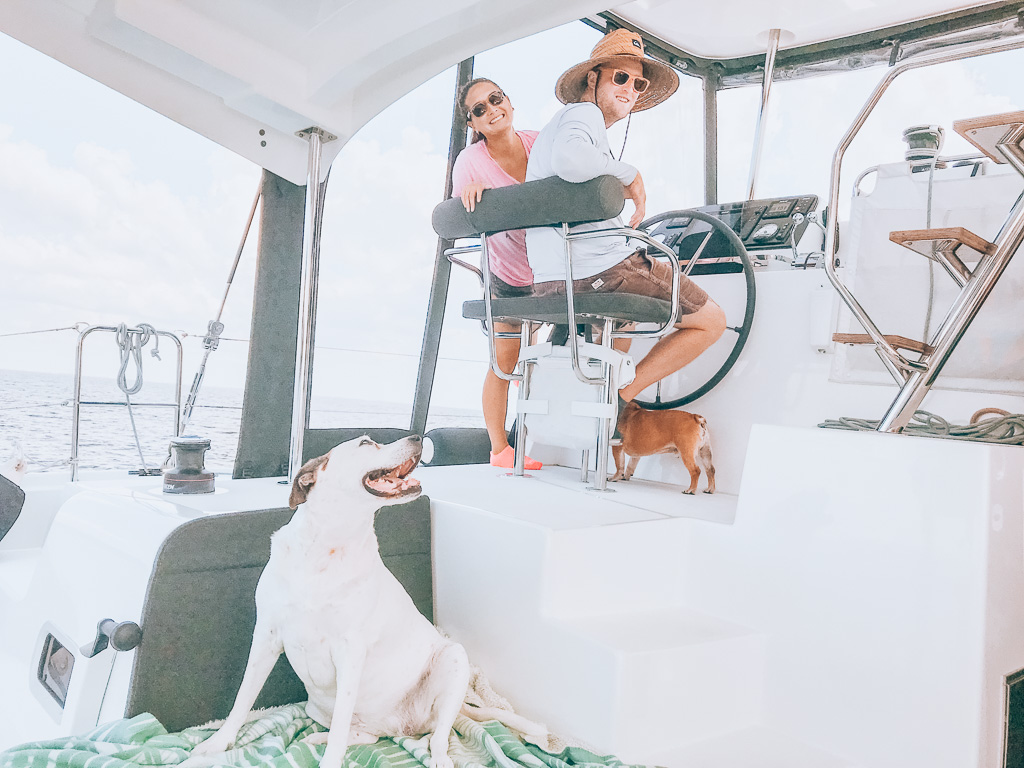
The four of us on SV Paradise (our boat)
About our dogs, Sailor and Mr. French.
Our bigger dog is Sailor, and she is about 85 pounds and is over 13 years old. Our smaller dog is Mr. French, and he is a 15-pound French Bulldog who is over 11 years old. We’ve had them since they were puppies (we adopted both of them) and love them so much!
Mr. French is happy to be wherever we are, and he doesn’t care much for being outside so he makes the perfect pet for an RV or boat. He enjoys sailing and likes to be right at the helm with us.
Sailor enjoys all of the smells when we travel to new places as well as the attention and petting from being a big dog at a campground, marina, or anchorage. Due to her bigger size, we have to do more to make sure she is comfortable and happy, but it is all worth it. She is a great hiking buddy and is very friendly and social with new people.
Honestly, while traveling with a dog is more work, I can’t imagine what it would be like to travel without them. They bring us so much happiness and love, so it is well worth it to us.
When traveling with a dog, here are my tips so that both the humans and animals are happy and healthy.
Here’s how to start traveling with a dog.
1. Take it slow when introducing your pets to travel.
If you want to start traveling with a dog, then I recommend taking it slow.
Whether you are going to live in a boat or an RV full time, or are just going on a weeklong road trip, I recommend slowly introducing your dog to travel.
This is the top tip we’ve heard from others who travel with their dogs, and it’s very true.
So, instead of throwing your pets into a long trip, you may want to start with something much smaller, so that they can get used to the process. You will be completely changing their routine, and many pets are used to following routines each day.
I also recommend trying to keep some of their routines as close to normal as possible, such as feeding times and when you let them out for exercise and bathroom breaks.
For example, when we started sailing, numerous people suggested starting the dogs out at a marina, then doing day sails, then an anchorage, and go from there. So, that’s exactly what we did. We didn’t want them to be afraid of sailing or make them afraid to get on the boat, so we took it as slow as possible. That’s worked out well for us, and we recently did a 9-day sail with them, and they acted like it was no big deal at all.
We got them very comfortable with being on the boat, and we haven’t had to quit just yet, so I would say it was a huge success.
If you are not planning on traveling full-time, but want to go on a road trip with your dog, I recommend not traveling too far at first, especially if they’re not used to being in the car. Slowly introducing them to travel is good so that they don’t get scared or stressed out. So, you may want to start by bringing them to a park nearby to help them with their nerves, as some dogs can be quite anxious!
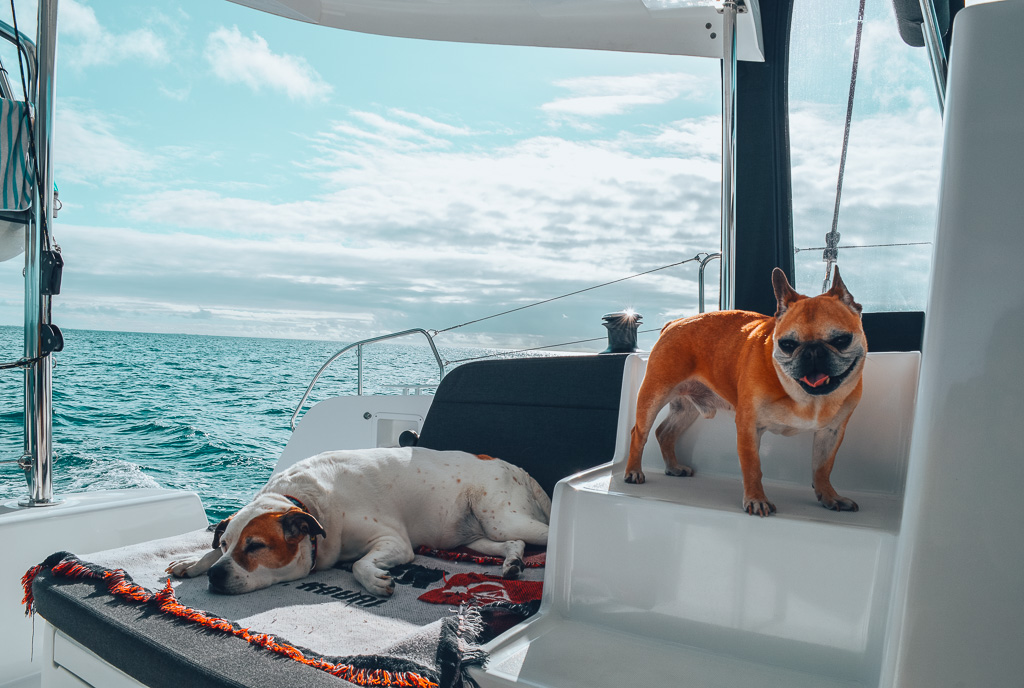
This is what a normal day on the water looks like.
2. Know the rules and customs of where you are going.
Not every place you go to will be pet friendly.
When traveling with a dog, you will quickly learn that not every park or trail is open to dogs. Most national parks are this way and don’t allow dogs on the trails.
However, there are some national parks that do. This is why I recommend doing some research ahead of time so that you are not surprised or frustrated when you get to your destination.
No matter where you are traveling with a dog, respect the land and the people there. You should always pick up after your dog, even if that means that you will have to hike for hours with a dog waste bag. You should not let your pets trample over delicate areas, and don’t let them approach people who don’t want to be bothered.
The same also applies to campgrounds and hotels. You will want to make sure that you find dog friendly camping, dog friendly hotels, and more. You’ll want to call in advance to make sure the weight and breed are acceptable.
3. How to do veterinarian visits.
Going to the vet is an important part of being a pet owner, and you still need to do it when you’re traveling with a dog.
I receive a lot of questions about how we handle this.
Our dogs still see the vet each year, and sometimes more often if there are any issues. They just usually see a new vet each year. If we’re in the same place for longer than a year, then they might see the same vet more than once.
Our dogs have never had an issue going to a new vet, and they go each time with no problem. We simply make sure to bring all of their paperwork with us so that there is no confusion as to what was done at a previous appointment.
When it comes to medications, we try to stock up on what we need for the whole year.
If you’re going to start traveling with a dog, especially full-time here are some thing you’ll want to bring up with your vet to prepare:
- Getting your dog microchipped. This is a great thing to have, and if you are going to a new country then it is usually mandatory.
- Rabies vaccination – this is normal.
- Seeing what vaccinations and medications are recommended or required in the area you will be traveling to in the next year. This can vary even state by state!
4. How to visit new countries with dogs.
When visiting new countries with our dogs, there have been a lot of steps and hurdles to go through.
Here are some of the preparations you may need to make when traveling with a dog to a foreign country:
- Contact the government veterinarian agency of the country you are seeking to visit and ask for an up-to-date list of requirements for bringing a pet.
- Bring your dog to a veterinarian where you are currently located and get all of the required shots, tests, paperwork, etc.
- Visit the USDA or the equivalent in the country you are in to get your paperwork certified and stamped.
- Send all of the required paperwork back to the government veterinarian in the country you are desiring to go to and have them approve it. You will also need to get a permit from them for your pet to enter the country.
- Then, once you get to the new country, you may have to bring your pet to the government vet so that they can make sure it is the same pet on the paperwork, as well as to make sure the pet is healthy.
Now, these aren’t the exact steps for every single country, as every country has its own process.
The process can take several months from beginning to end, so you will want to make sure that you budget for plenty of time to get everything ready. When you’re boating with dogs, especially around the Caribbean, you can spend a lot of time researching this kind of stuff.
You’ll want to make sure you follow the steps exactly as detailed by the country you are going to, because doing them out of order (such as getting the vaccinations in the wrong timeline) will invalidate the process. This can be a costly and timely mistake, but it’s avoidable.
When you’re traveling with a dog or another pet, I also recommend:
- Try to bring as much food for your pet as you can. We usually bring several months of dog food with us, as there may not be as many choices where you are going.
- Keep your dog on a leash when it is required, if there are people near, and so on. And, always follow the leash rules of the area you’re visiting. Not everyone in other countries and areas like dogs, so you will want to keep that in mind.
- When you go to the vet, try to get any standard medications that you may need. For example, our bigger dog can sometimes have an ear issue that requires a liquid steroid that you insert in her ears. We always try to have at least one backup on us so we don’t have to try to find a vet, as it can be quite difficult in foreign countries to get your dog to a vet if you don’t have a car, and not all islands have a vet either.
- In some countries and/or areas, you may have to keep your pet documents on you at all times as you may be asked to show it at random times.
While it is a lot of work to bring your dog to a new country, it is possible and most government vets are super nice and helpful.
Some helpful resources for more information on each specific country include:
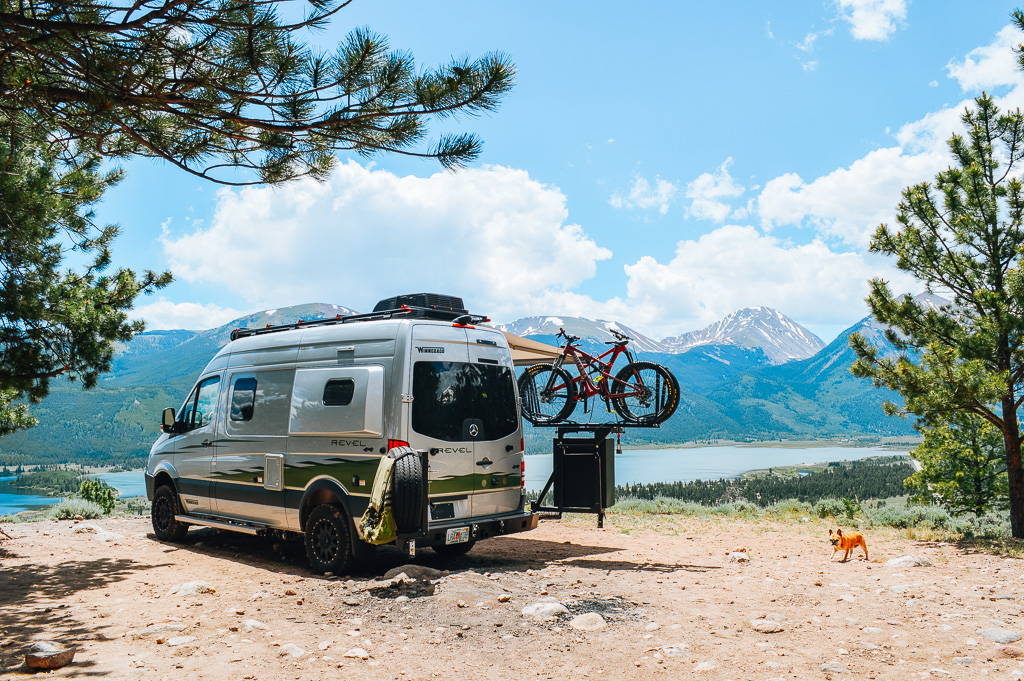
Can you spot Mr. French?
5. How to keep a tiny area clean when traveling with pets.
We keep our home as clean as it can be, which usually means vacuuming every single day. Our bigger dog sheds a ton, and we would be choking on hair all day if we didn’t vacuum as much.
We use a Dyson vacuum (this is the one that we love) and it works great. It’s small, rechargeable, and super portable.
We bring this with us whether we’re on the van or in the boat. Highly, highly recommend.
6. How to keep the temperature comfortable in an RV or boat for a pet.
For us, we try to follow good weather as much as we can. However, I know that is not always possible.
There are devices where you can track the temperature over a cell signal back to wherever your dog is (you can find a whole bunch of them on Amazon), which can be a great option. However, you might not always have a signal.
If we are unable to make the temperature comfortable for our dogs or if the electrical power isn’t stable, we simply do not leave our dogs alone.
But, it usually isn’t hard to make it comfortable for them. By opening windows, turning on fans, or the AC, you can make it pretty comfortable for both humans and pets.
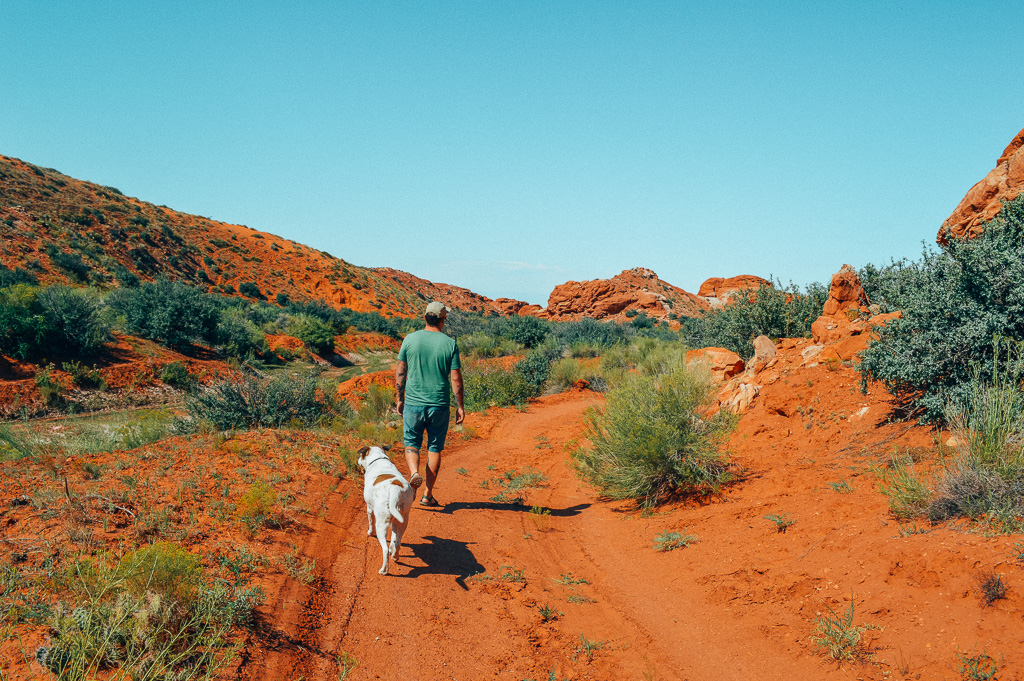
Walking in Utah
7. Full-time travel with dogs – how they use the bathroom on the boat.
This is one of the most common questions we’re asked about traveling with a dog. People are fascinated with how our dogs go to the bathroom on our boat.
We always try to make regular and frequent bathroom breaks for our dogs.
Whether we are traveling by boat or car, we like to keep bathroom breaks as similar as possible.
We were nervous training our older dogs to use the bathroom on the boat, but it has been just fine. They only have to do this when we’re on an overnight sail, so it’s not very often. Keep in mind that 90% of the time you’re living on a boat is either at anchor or in a marina, so there is almost always land access.
When we look for a marina or an anchorage, we are always looking to see if there is a good area to let out the dogs. That may mean a beach, a grassy area, a dinghy dock so that we can walk to town with the dogs, and so on.
A lot of people falsely assume that when you’re sailing full-time, neither you or your pets touch land for years at a time, and that assumption just makes me laugh. Our dogs go to shore multiple times a day, except for when we are doing a long passage (which isn’t often).
Depending on where we are, we may have to take them for a short dinghy ride to shore or we’re at dock and can simply walk them off the boat to use the bathroom.
If we are doing a longer passage on our sailboat and there is no land for them to step their paws on, we do have fake grass on our boat that they are able to use. It doesn’t happen often though, and most of the time they still get walked 3-5 times a day even when we are on our sailboat.
8. How to keep dogs safe on a boat.
The longest sail that we have done with our dogs was 9 days, and they did extremely well on that sail.
Some of the things we do to make sure they are happy and safe include:
- One of us is pretty much always keeping an eye on them. If we can’t pay close attention to them, then we put a leash on them or close off the inside area so they cannot fall overboard. (If you decide to leash your dog, please make sure they cannot fall off the boat and choke themselves. This applies to being on the boat, dock, land, etc. Sadly we know someone who had this happen to their dog and it had a very sad ending.)
- We have life jackets for each dog, and we’ve tested them before bringing them out for sails.
- At night, we keep everything closed off so that there are absolutely no worries with the dogs.
- We make sure there is plenty of water, food, snacks, and snuggles.
We are lucky that our dogs are quite comfortable on the boat.
They don’t panic or bark.
They simply fall asleep and are relaxed when on the boat.
I think this ties back into #1 of this blog post – we slowly introduce them to new things. This has allowed them to be quite adaptable to any environment that they are put in, whether we are tent camping, roadtripping, in an RV, or on an overnight sail.
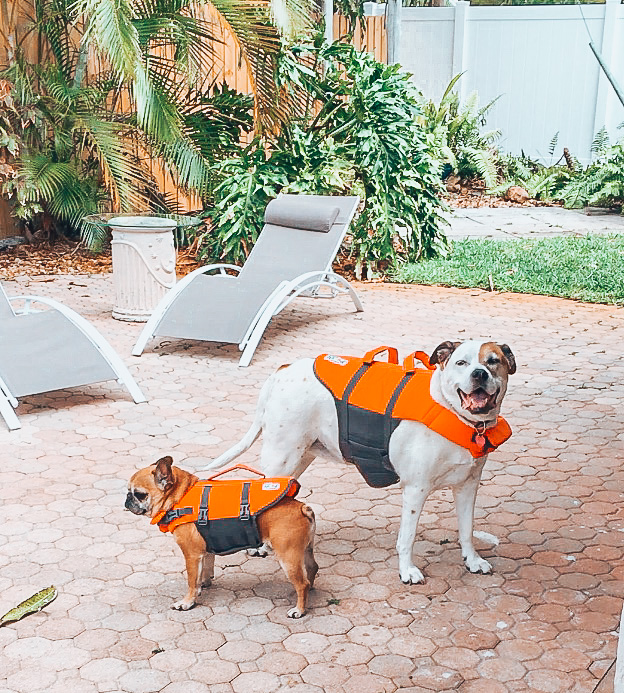
Testing out their new dog life jackets
9. The items that make it easy for traveling with a dog.
We have a lot of items on the boat that are specifically for our dogs, and many of them come with us when we move to our camper van. Here are the most helpful items we have:
- Dog ramp – This is for when we are at a fixed dock, where it’s a long hop from our transom to the dock. We had a plastic one for a little bit but we found that it would bend in the heat so we had to switch to something better. We are much happier with an aluminum ramp now.
- Dog toys – To keep our dogs busy and happy, I like to put peanut butter in a Kong and give it to them as a nice treat.
- Dog waste bags – We keep a plethora of these onboard our boat and van. We usually bulk buy a big box of around 1,000 bags. We also make sure they are biodegradable and compostable.
- Help ‘Em Up Harness – This is the harness we have for our bigger dog, and I highly recommend it. We put it on her so that she can easily get in and out of steeper places. It’s a little pricey, but well worth it to make sure your dog is safe.
- K9 SportSack – We use this for our smaller dog so that we can easily just carry him around. He’s not a huge fan of walking everywhere so putting him in the backpack makes it easier on everyone.
- Collapsible bowl – We always keep one of these in our hiking bag so that the dogs always have something easy to drink out of.
- Life jacket – If your dog is going to be on a boat, you’ll want a life jacket for them.
10. Getting exercise is still important.
Some people think that having a dog on a boat or in an RV is bad for the dog. I don’t think that could be further from the truth, though.
Our dogs get 3-5 walks (sometimes more) each and every single day.
Exercise is so important whether you’re camping with a dog, sailing with them, etc. Don’t assume you’ll fit in walks – you have to plan them in advance.
We always make sure to give our dogs a long walk at the start of the day if we know we’re going to have a long drive or sail. This way, we can try to tire them out and get rid of a lot of energy.
Taking them for a walk is one of the first things we do when we stop, and then we always fit in another long walk before bedtime. You may feel exhausted after a long day of sailing or traveling, but don’t forget how important exercise and routines are to your pets.
11. Have a traveling checklist.
Before you leave for wherever you’re going, I recommend bringing anything you think you’ll need, even if you don’t end up using it. This may include:
- Pet food
- Water and food bowls
- Collars, leashes, harnesses
- Dog waste bags
- Treats
- Blankets and beds
- Medication
- Paperwork
Specific pets may need different items, and go over your list before you leave.
12. What about traveling with a dog on a plane?
I would be careful if you are wanting to fly places with your pets where they have to go in the cargo area, as it can be traumatizing to put them in the cargo area of a plane. It can be extremely hot, scary, and they will be away from you for quite some time.
I know several people who have moved to a new country and flew their dogs in cargo in order to make it possible to bring their pets. But, nearly all of these people have told me that they would never do it again, unless absolutely necessary.
If you are going on short trips by plane, I would not recommend putting your pets in cargo for that. Instead, if you have to bring your pet, I would simply find another way to travel. Or, you can find someone to watch your pet.
If your pet can sit with you on the plane, then that’s a whole different story. They may be just fine on the plane, but you should consult with a veterinarian if you have any questions. We’ve avoided flying with our dogs, so I’m just not as familiar with it.
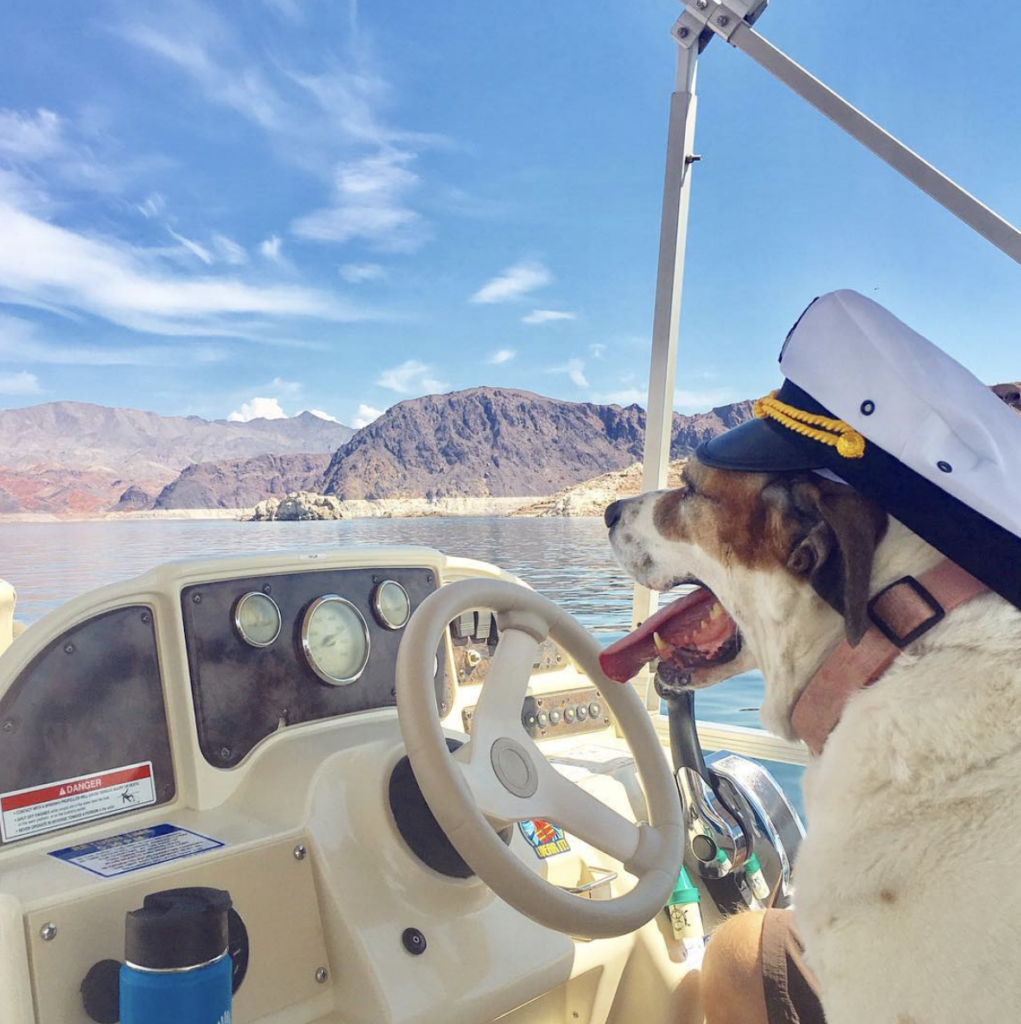
We rented a pontoon in Nevada several years ago with the dogs
Traveling with a dog – in summary
I hope you found today’s article helpful.
Please remember that I am not a pet expert, nor a veterinarian. I do have a lot of experience traveling with a dog, but all pets are different. They have different needs and personalities, and what works for my dogs may not work for yours.
So if you have any concerns about traveling with your pet, please contact your veterinarian.
Traveling with a dog can be extremely enjoyable, but there are a few more things you’ll have to think about.
If you’re anything like me, though, it will be well worth it and your pet will enjoy it as well!
Do you like to travel with your dogs? What other questions do you have for me?